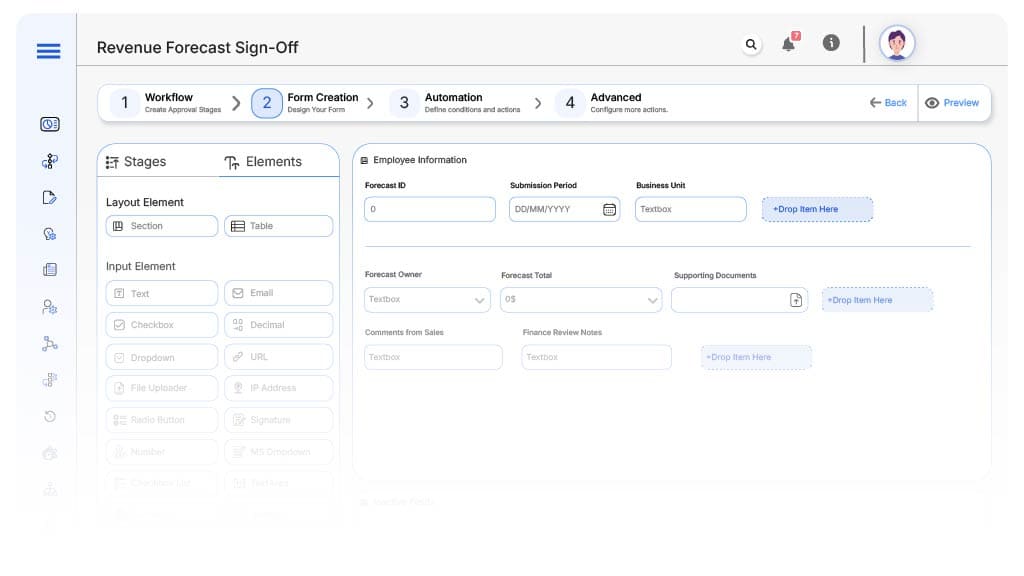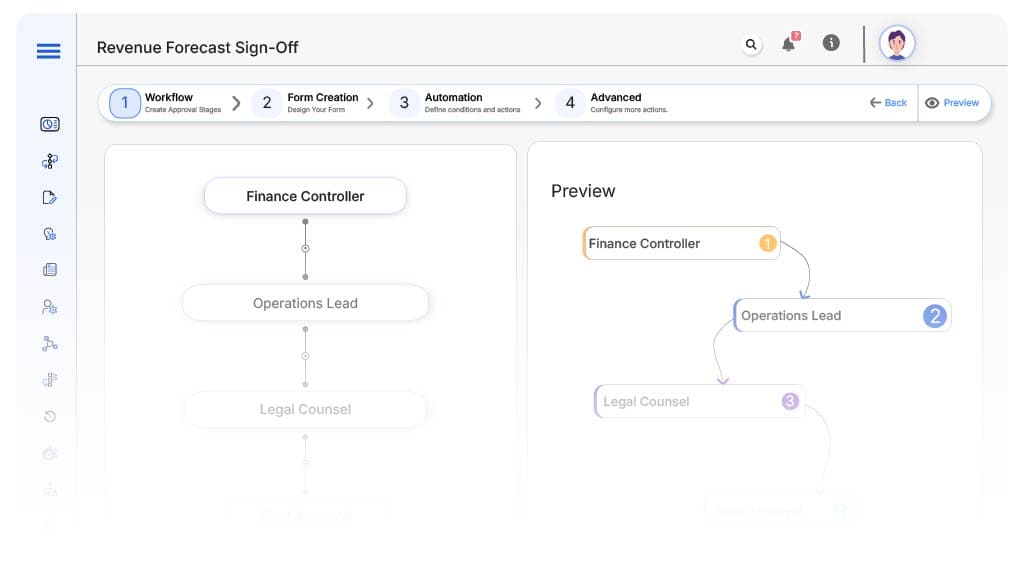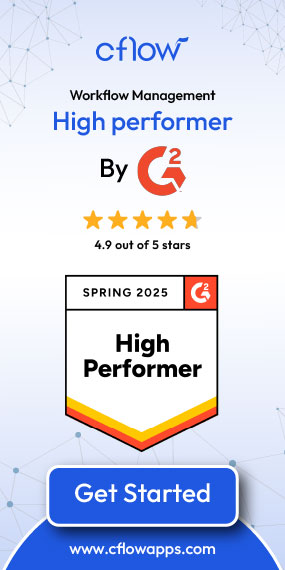- Cflow
- Revenue Forecast Sign-Off Automation
Revenue Forecast Sign-Off Automation

Clow Team

Accurate revenue forecasting is critical for planning, budgeting, investor reporting, and business strategy. Yet, manual sign-off processes often delay approvals, cause version control issues, and lead to inconsistent assumptions across teams. A study by EY found that 66% of CFOs lack confidence in their revenue forecasts due to fragmented workflows.
Without automation, finance, sales, and executive teams rely on spreadsheets, emails, and last-minute meetings to validate projections. This guide outlines how Cflow automates Revenue Forecast Sign-Off, from initial forecast submission to final executive approval, with clear visibility and compliance at every step.
What Is Revenue Forecast Sign-Off Process?
The Revenue Forecast Sign-Off Process governs how forecasts are submitted, reviewed, validated, and approved across sales, finance, and leadership. It ensures that revenue predictions are aligned with business goals and financial models.
Think of it as a formal checkpoint where revenue assumptions meet business scrutiny before being finalized. Without sign-off rigor, forecasts become guesswork, risking inaccurate budgets and misguided decisions.
According to Deloitte, companies that automate revenue forecast validation report a 30% faster close cycle and 50% fewer forecast revisions.
Why Revenue Forecast Sign-Off Automation Matters for Organizations
Faster Sign-Off Cycles
Consistency in Review
Risk Mitigation
Improved Cross-Functional Alignment
Audit-Ready Documentation:
Key Benefits of Automating Revenue Forecast Sign-Off with Cflow
- Forecast Trigger & Timeline Alerts: Cflow lets teams define revenue forecast cycles and sends timely alerts before deadlines, ensuring that submissions are never missed. This keeps the entire forecasting process on schedule without relying on manual reminders. Teams stay organized and ahead of critical timelines at every stage.
- Role-Based Review Routing: Forecasts are automatically routed to the right stakeholders based on business unit, region, or forecast value. Each reviewer receives tasks tailored to their role, improving clarity and accountability. This eliminates routing errors and accelerates review turnaround.
- Multi-Level Approval Workflow: Cflow supports multi-tiered approvals that follow a clear path from Sales to Finance to Executives. Each reviewer has defined responsibilities and timelines to follow, reducing delays and confusion. This structure brings discipline and visibility to the sign-off process.
- Data Validation Rules Built-In: Forecast entries are validated using built-in logic to detect missing data, unrealistic numbers, or mismatched targets. Any anomalies are flagged automatically for review before submission. This ensures that only reliable and accurate forecasts move forward in the workflow.
- Version Control & Commenting: All forecast versions are tracked with time-stamped logs and reviewer comments, offering full visibility into what was changed and why. Users can view side-by-side comparisons between revisions. This reduces miscommunication and supports informed decision-making.
- Escalation on Delay: If a reviewer delays action, Cflow escalates the task using SLA rules and notifies the next level automatically. This helps prevent bottlenecks that typically occur in manual workflows. Escalation rules keep the process moving even when key approvers are unavailable.
- Executive Access on Mobile: Executives can access, review, and approve forecasts on mobile devices with document previews and comment history. They no longer need to be in the office to complete their part. This flexibility speeds up final sign-offs and improves continuity in financial planning.
Get the best value for money with Cflow
User Roles & Permissions
Sales Manager (Initiator)
- Responsibilities: Submit forecast by product, region, or channel with revenue assumptions.
- Cflow Permission Level: Submit Form
- Mapping: “Sales Team”
Finance Controller
- Responsibilities: Review fund availability, cost center impact, and financial feasibility.
- Cflow Permission Level: Approve/Reject.
- Mapping: “Finance Team”
Finance Controller
- Responsibilities: Review submitted forecasts for consistency, accuracy, and alignment with financial plans.
- Cflow Permission Level: Approve/Reject
- Mapping: “Finance Team”
CFO / CEO (Final Approver)
- Responsibilities: Provide final endorsement before the forecast is published.
- Cflow Permission Level: Approve/Reject
- Mapping: “Executive Leadership”
Discover why teams choose Cflow
Form Design & Field Definitions

Field Label: Forecast ID
- Type: Autonumber
- Auto-Populate: Generated on submission.
Field Label: Submission Period
- Type: Date Range
- Logic/Rules: Defines forecast window
Field Label: Business Unit
- Type: Dropdown
- Logic/Rules: Drives routing
Field Label: Forecast Owner
- Type: Text
- Logic/Rules: Required
Field Label: Forecast Total (USD)
- Type: Numeric
- Logic/Rules: Drives approval level
Field Label: Supporting Documents
- Type: File Upload
- Logic/Rules: Requir
Field Label: Comments from Sales
- Type: Text Area
- Logic/Rules: Required
Field Label: Finance Review Notes
- Type: Text Area
- Logic/Rules: Required
Field Label: Operations Feedback
- Type: Text Area
- Logic/Rules: Required if capacity concerns exist
Field Label: Legal Observations
- Type: Text Area
- Logic/Rules: Required if legal review is triggered
Field Label: Executive Sign-Off
- Type: Checkbox
- Logic/Rules: Marks approval completion
Transform your Workflow with AI fusion
Approval Flow & Routing Logic

Submission → Finance Controller
- Status Name: Pending Finance Review
- Notification Template: “New revenue forecast submitted. Please validate assumptions and totals.”
- On Approve: Moves to Operations
- On Reject: Returns to Sales Manager
- Escalation: Reminder after 1 day
Finance Controller → Operations Lead
- Status Name: Pending Ops Validation
- Notification Template: “Please verify forecast against operational capacity and constraints.”
- On Approve: Moves to Legal (if required) or Executive
- On Reject: Returns to Finance
- Escalation: Reminder after 1 day
Operations Lead → Legal Counsel (if needed)
- Status Name: Pending Legal Review
- Notification Template: “Legal review required for high-value or contract-linked forecasts.”
- On Approve: Moves to CFO/CEO
- On Reject: Returns to Operations
- Escalation: Reminder after 1 day
Legal → CFO/CEO
- Status Name: Pending Final Sign-Off
- Notification Template: “Forecast ready for executive endorsement and publishing.”
- On Approve: Moves to Approved
- On Reject: Returns to Legal
- Escalation: Reminder after 1 day
Final → Approved
- Status Name: Revenue Forecast Approved
- Notification Template: “Forecast approved. Ready for reporting and execution.”
Transform your AI-powered approvals
Implementation Steps in Cflow
Create a new workflow
Design the form
Set up User Roles/Groups
Build process flow
Set escalation rules
Integrate with systems
Test scenarios
Go live
Example Journey: Revenue Forecast Sign-Off
FAQ's
Unleash the full potential of your AI-powered Workflow

